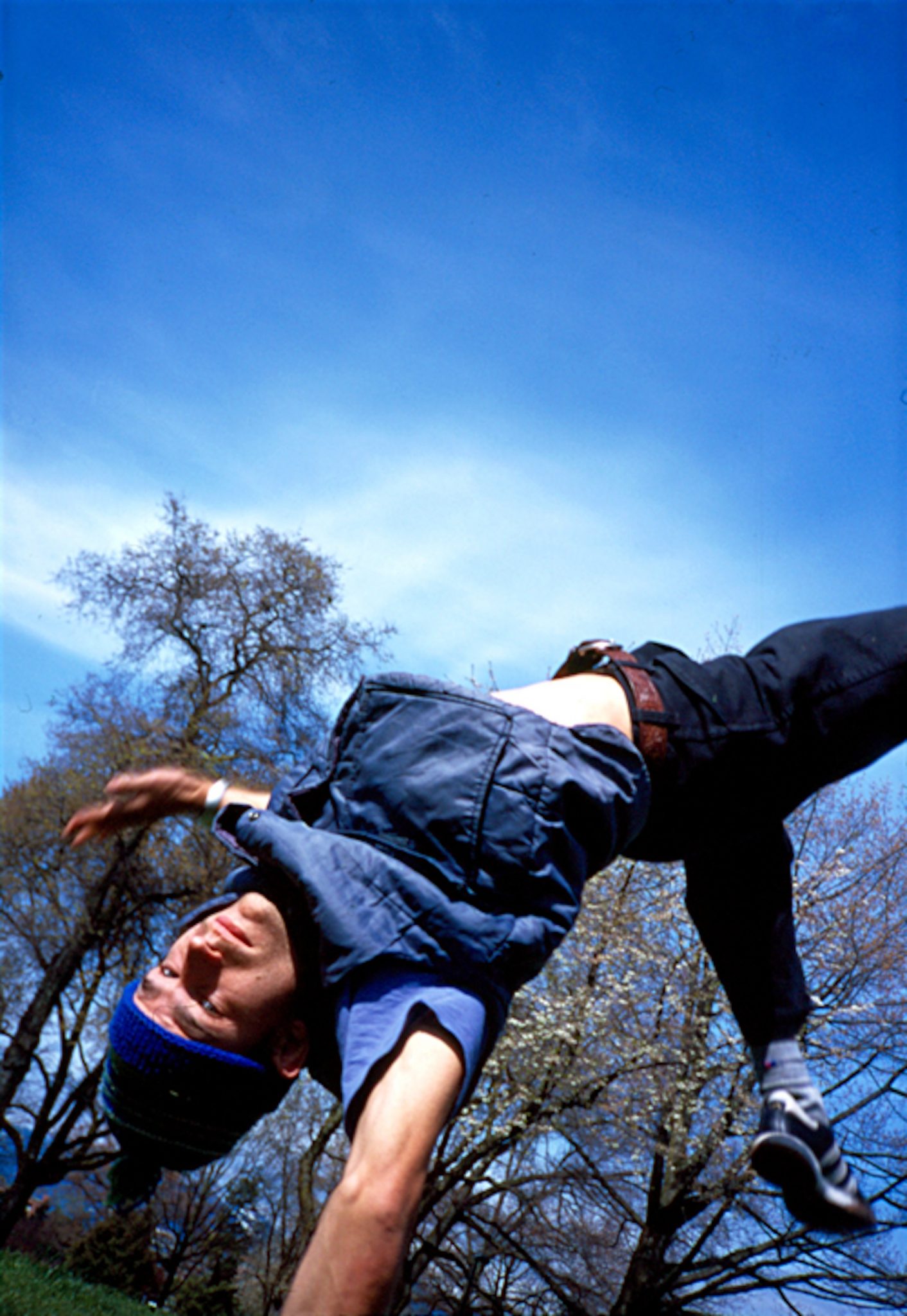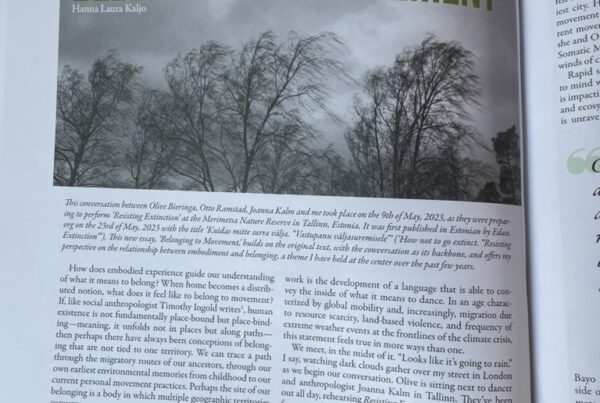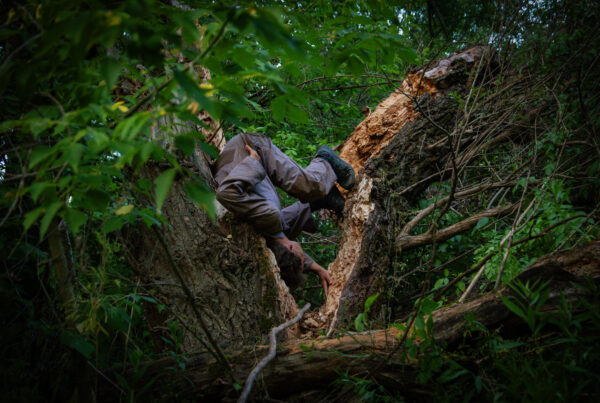author: Otto Ramstad
source: Contact Quarterly
date: March 25 2006
The senses develop in sequence: kinesthetic, touch, smell and taste, and then vision. When our vision is developing we associate it with all the other sensations that we have that have more fully developed. The life of our early life is a synesthetic blend of sensation. Though this synesthetic wash is much more alive in the preverbal state, as adults we still synthesize between the different senses. As we see things visually in the world we also have other sensory reference to them. When looking at the choppy ocean on a cloudy day we think, “That looks cold.”
Vision also leads toward curiosity of the other senses. We see something that we are unfamiliar with and we want to touch it. Or taste it. Or listen closer. Actually sound often goes the other way, we hear something and we want to see what it is.
We make food look good because we want people to visually taste it first. Kinesthetically we empathize with movement that we see happening in the environment around us. The movement in the environment causes us to move in a certain way just because we saw it and took it into our bodies through our eyes. So vision is a doorway to the kinesthetic sense, as well as to the other senses. This is the potential of dance film. Can we make a film that makes people feel things? Showing them how we sense the world. How we make sense of it. How we compose the senses to make something. How the environment composes us. Making a dance film is making sense. We can show the inside score of what makes a dance. What it is like to be in a dance, in a dance state. We can show what a dancer sees in a dance. It is a collage of parts, not the whole image seen inside of the proscenium arch. Being in the environment we can show how dancers are responding to the environment by depicting them doing the responding. Presenting an image of how they are experiencing by the inclusion of the surrounding environment and sharing, hopefully, the way that they are seeing and feeling through the way we use the camera.
One of the reasons we work with improvisation is that the shifting between the senses is in time is very real whilst improvising a dance. It is being discovered. And the cameraperson is also discovering it as well. Following their vision, sounds they hear, kinesthetic impressions, textures of vision and touch. As an audience one can ride both the dancers and the cameras impressions of the environment.
Blindfold work is something that we use to acclimate ourselves to places. It is a way to enter first without initial visual assumption, or a way to work with a place you already know to get beyond your visual assumptions. Even though we can approximate the experience of the other sense through vision it is still not the other senses. It is so fun to travel through touch, smell, sound and taste and then visually see where you are and where you have been, fun to construct those associations with your vision.
Working with video in the making of dances creates a unique climate of attention. It is different than performing for an audience of many, different than performing for a witness of one, and different to working on your own. As a dancer you are able to track the attention of the perceiver/videographer by seeing where the camera is pointed if up close but you are unable to know where the attention is directed if the camera is far away. In the first sense you have the challenge of focusing and directing your attention even when you know that no one is looking or recording you. And in the second sense you have to be present in every cell of your body because you don’t know when you will be looked at or recorded in any part of the work that you are making, especially in that there is a zoom lens that can focus on any part of you at any time, including your face.
Developing this kind of work in environments creates a feedback loop between the dancers, videographer and the environment. This is an intimate dance of attending to sensation as a field of differentiated and undifferentiated perceptions and feelings. In this field the dancers and cameraperson are following the illogical logic of preference to frame images. This is both a conscious and unconscious process. The video is capturing the texture through sound, light and kinesthetic response of the dancer. Having the camera between the dancer and the videographer creates a non-social space. It is a space that focuses the dancer on the material that s/he is working on in the body and in relation to the environment.
The relationship to time is also different. It is a combination of the spaciousness of time in that there is not end of performance cue to attend to. There is no audience to sense if the attention is waning, whether or not yours is. Because of this there is the feeling that time expands. This feeling is combined with knowledge that the time you are spending in this space, in this dance is being recorded ‘forever’. This combination of expansiveness and the quickening feeling of the eternal outcome create a state that is very supportive for making dances and dances in the environment. There are also the elements of time that you can choose; to have a dance choose their own ending or the cameraperson can call cut. Or the camera can push the time continuing to focus on the dance when is seems like it is finished impelling the material further.
The mobility of the camera mirrors and reveals the mobility of the eyes and attention of the dancer in the environment. The attention of the dancer moves their body through the environment. The camera and the dancer direct that audience’s attention through the environment.
We don’t “rehearse” the work per se. When working in environments with dance and video we are interested in creating a climate where the camera sees the dancer discovering and then playing with the environment. We work with the material that is present and videotape it all. There usually ends up being no hierarchy between what material gets used or not in the final edits between the raw beginnings of arriving on a site or later on in time when the material was more known. It is just as interesting to see both dancers and camera people discover an environment, as it was to see someone make more informed choices with a developing sensibility of working with known material. There ends up being a shift in the working with the environment. In the beginning the discover process of new sensations and feeling floods the attention. A rush of new impulses and kinesthetic configurations are woken up dealing with new terrain. As we continue to work and the newness of the environment lessens in the mind we begin to notice the subtler ways that the environment is tuning us. The ease of fitting the bodies shape into the lands contours. The reflexes availability to respond to uneven terrain increases with less vigilance from the eyes while moving through the space. This process of subtle tunings makes one attend in a different way to the environment without having to attend to the initial flashes of new images and the overt survival aspects. Then one can choose higher levels of risk of survival and expression of composition that is potentially more innately fused with the environment.
Building the score means building the cast, the site, the weather, the light and the cameras adjustments. These are materials that we are improvising composition with; this distilled palette energizing our attention and the collaboration of these materials becomes the content of the film. It borders on ironic that we sink into deeper layers of embodiment and are able to share our way of working through the mediation of the camera and the screen. The attendant physical and attentional shifts that come within the constellation of dancer, environment, and camera create a container holding a pool that is clarified by the holding. The silt that has settled to the bottom and the wind that has been shielded are still present but do not mar the image of the surface.



